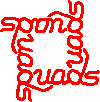
ARTICLES
About Quads
Jargon
Etiquette
Swinging Tips
Hand Positioning
Dance Attire
Hoedowns
Festivals
Levels and Lists
Advice for the New Graduate
What Makes a Good Dancer
Advice for Angels
Stanford Quads
Square Dance Club
Square Dance Etiquette
by Bill van Melle, October 23, 1994
Here are a few tips on square dance behavior--customs peculiar to square dancing, as well as common sense reminders to respect your fellow dancers.
When squaring up, if your square needs more dancers, the convention is to hold up fingers indicating the number of couples needed. At a singles club such as ours, you may also see a bent or crossed finger requesting half a couple; however, the usual procedure is to find a partner before trying to form a square.
- This is somewhat different from the usual convention in gay clubs, where they hold up fingers to indicate the number of individuals required, and you are not always expected to have lined up a partner before squaring up.
If your square breaks down, try not to waste time getting angry at yourself or anyone else. We all make mistakes sometimes, and square dancing is supposed to be fun, after all. If you stop to argue about who messed up, or exactly what went wrong, you'll miss even more calls, and you'll make it harder for the people still dancing to hear the calls. In the same vein, when your neighbor makes an error, do not push or shove him/her back into place--be more subtle.
Be sure to square up quickly after you've broken down--this allows the caller to easily see that you're not dancing, and he'll try to get the other squares back home quickly so you can resume dancing. This may also inspire him to explain the troublesome call more carefully, but if not, wait until the next break and ask somebody.
- At many other clubs, it is traditional to "make lines" when you break down, conventionally done by squaring your set and having the Head couple slide over next to the Side couple, nudging them over to the right until you have nice facing lines. Now you can resume dancing at the next point where the caller says you have normal lines. You may not come out with your partner at the end this way, but at least you can keep dancing. At Quads, normal-sex lines occur less frequently, and John is usually good about resolving quickly when he sees you're down, so it's easier just to square up.
Use gentle handholds! It's important to establish hand contact with adjacent dancers in your formation, but you don't have to bruise them to do it. Handholds are an important way in which dancers guide each other, since no one can be alert every second; however, you should hold on loosely so the other dancers can get away if they are supposed to move and you don't realize it. When doing a Left Allemande, grip the forearm, not the elbow. When standing in an ocean wave, hold your palm and fingers gently against those of the adjacent dancer--don't grab thumbs. After you do a Left Allemande or Pull By (e.g., in Square Thru, or Right and Left Thru), don't forget to let go as you pass each other.
Since square dancing involves a lot of close contact, you should, of course, try not to gross out your fellow dancers by having icky stuff on your hands, eating three heads of raw garlic for dinner, bathing in perfume, or not having taken a shower in recent memory.
Please don't ingest alcohol or other drugs that impair your coordination or memory before dancing.
Last updated Wednesday 8 August 2007